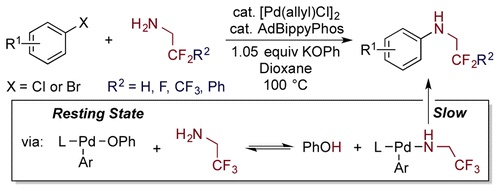Palladium-Catalyzed Arylation of Fluoroalkylamines
J. Am. Chem. Soc., 2015, 137 (8460–8468)
View on publisher site
Abstract
We report the synthesis of fluorinated anilines by palladium-catalyzed coupling of fluoroalkylamines with aryl bromides and aryl chlorides. The products of these reactions are valuable because anilines typically require the presence of an electron-withdrawing substituent on nitrogen to suppress aerobic or metabolic oxidation, and the fluoroalkyl groups have steric properties and polarity distinct from those of more common electron-withdrawing amide and sulfonamide units. The fluoroalkylaniline products are unstable under typical conditions for C–N coupling reactions (heat and strong base). However, the reactions conducted with the weaker base KOPh, which has rarely been used in cross-coupling to form C–N bonds, occurred in high yield in the presence of a catalyst derived from commercially available AdBippyPhos and [Pd(allyl)Cl]2. Under these conditions, the reactions occur with low catalyst loadings (<0.50 mol % for most substrates) and tolerate the presence of various functional groups that react with the strong bases that are typically used in Pd-catalyzed C–N cross-coupling reactions of aryl halides. The resting state of the catalyst is the phenoxide complex, (BippyPhosPd(Ar)OPh); due to the electron-withdrawing property of the fluoroalkyl substituent, the turnover-limiting step of the reaction is reductive elimination to form the C–N bond.
Read on publisher's site